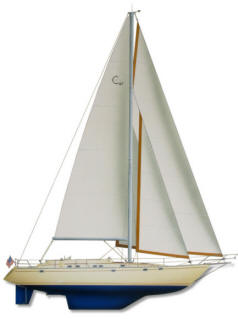loss of speed.
The wide decks with aggressive nonskid provide an efficient work platform. The lifelines lead forward to a true pulpit, with stainless-steel rails and twin anchor chocks. On-deck storage includes two forward and tow aft lockers for large gear and a double anchor locker. All winches are tow-speed and self-tailing and they’re powered by a single 18-volt Cinch Winch 1600 (cost $1,000) instead of $25,000 worth of electric winches.
What first wowed engineer Scott was Caliber’s tankage system, in which all tanks—each with a viewing port—are bonded to the hull below the waterline, strengthening the hull and creating a double bottom. This led the couple to Caliber’s trademark collision bulkheads, impact-resistance zones, watertight rudder dam, and sea chest, allowing just a single hole to be drilled through the hull.
The deal was closed when they went below to a varnished teak interior that has a teak-and-holly sole. The dinette is to port, the table folding up onto the bulkhead; opposite are twin easy chairs with a table/cabinet between. Handrails and fiddles are where they should be. Many opening ports and hatches provide plenty of cross-ventilation.
Just aft of the dinette is a nearly straight-line galley. In a seaway, crew can lean against the

enclosure over the engine and the 6-kilowatt genset (there’s 360 degree access to both). The nav station is to starboard, at the bottom of the companionway where it’s accessible from the helm.
The aft stateroom—with access thru the galley and via the aft head with shower stall, the nav station—has a cedar-lined hanging locker, a bureau, and a full queen berth. Karen’s joy is a walk-in closet to starboard. The cozy forward cabin has a full-double bunk to port, with bookshelves and cabinets above, and to starboard, a hanging locker, with a fiddled shelf on top.